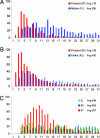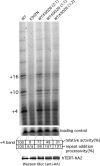Haploinsufficiency of telomerase reverse transcriptase leads to anticipation in autosomal dominant dyskeratosis congenita
- PMID: 16247010
- PMCID: PMC1276104
- DOI: 10.1073/pnas.0508124102
Haploinsufficiency of telomerase reverse transcriptase leads to anticipation in autosomal dominant dyskeratosis congenita
Abstract
Dyskeratosis congenita is a rare inherited disorder characterized by abnormal skin manifestations. Morbidity and mortality from this disease is usually due to bone marrow failure, but idiopathic pulmonary fibrosis and an increased cancer predisposition also occur. Families with autosomal dominant dyskeratosis congenita display anticipation and have mutations in the telomerase RNA gene. We identified a three-generation pedigree with autosomal dominant dyskeratosis congenita, anticipation, and telomere shortening. We show that a null mutation in motif D of the reverse transcriptase domain of the protein component of telomerase, hTERT, is associated with this phenotype. This mutation leads to haploinsufficiency of telomerase, and telomere shortening occurs despite the presence of telomerase. This finding emphasizes the importance of telomere maintenance and telomerase dosage for maintaining tissue proliferative capacity and has relevance for understanding mechanisms of age-related changes.
Figures





References
-
- Yabe, M., Yabe, H., Hattori, K., Morimoto, T., Hinohara, T., Takakura, I., Shimizu, T., Shimamura, K., Tang, X. & Kato, S. (1997) Bone Marrow Transplant. 19, 389-392. - PubMed
-
- Rocha, V., Devergie, A., Socie, G., Ribaud, P., Esperou, H., Parquet, N. & Gluckman, E. (1998) Br. J. Haematol. 103, 243-248. - PubMed
-
- Vulliamy, T., Marrone, A., Goldman, F., Dearlove, A., Bessler, M., Mason, P. J. & Dokal, I. (2001) Nature 413, 432-435. - PubMed
-
- Vulliamy, T., Marrone, A., Szydlo, R., Walne, A., Mason, P. J. & Dokal, I. (2004) Nat. Genet. 36, 447-449. - PubMed
Publication types
MeSH terms
Substances
Grants and funding
LinkOut - more resources
Full Text Sources
Medical
Molecular Biology Databases

